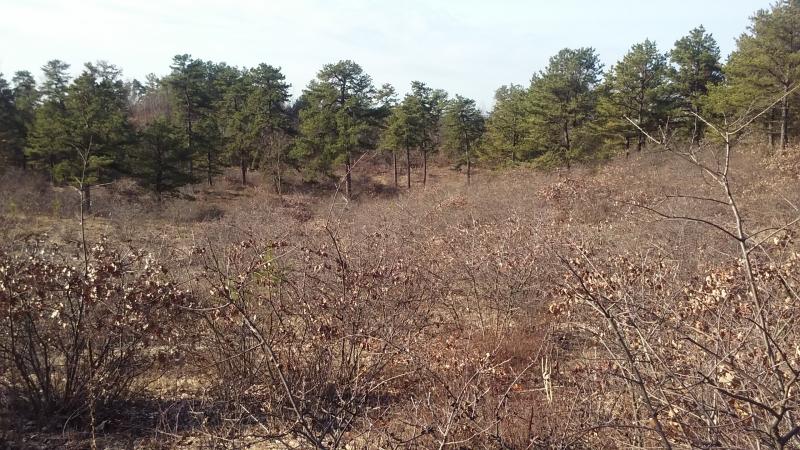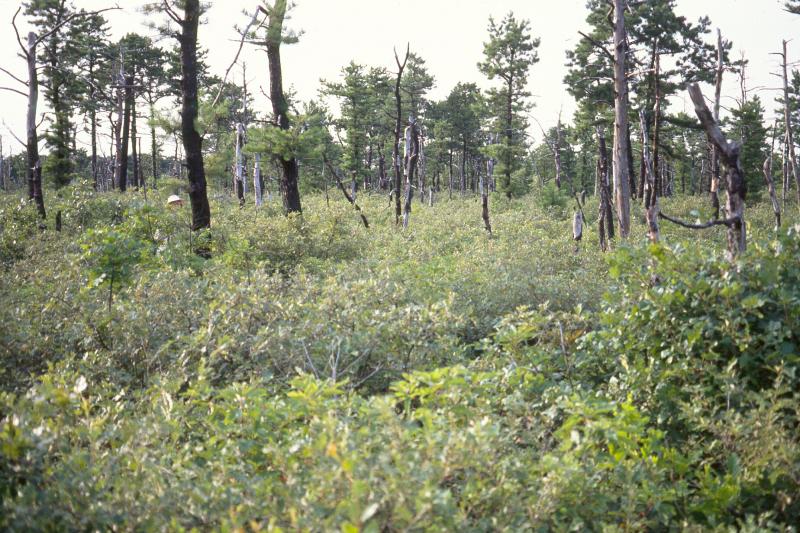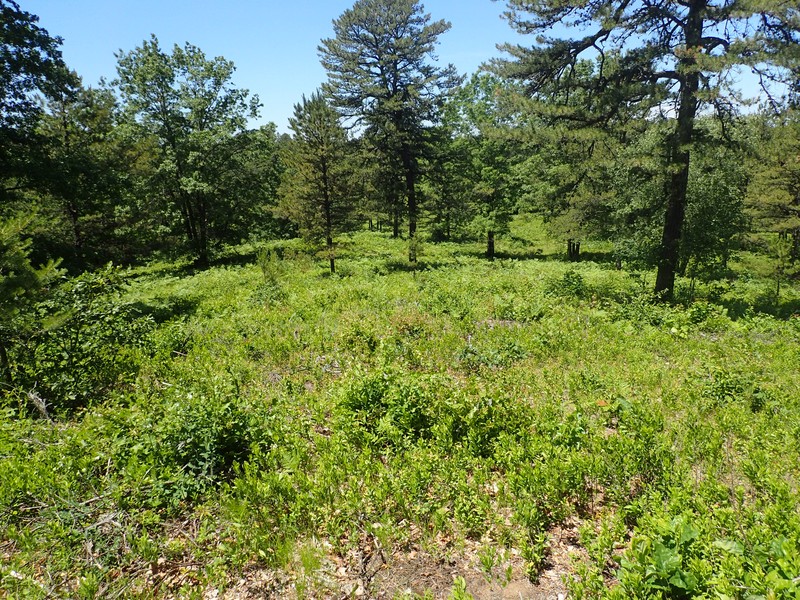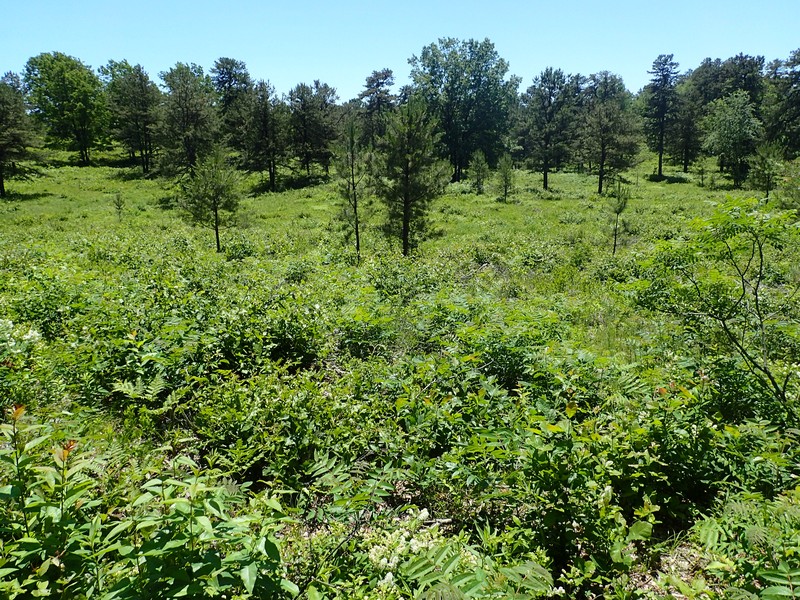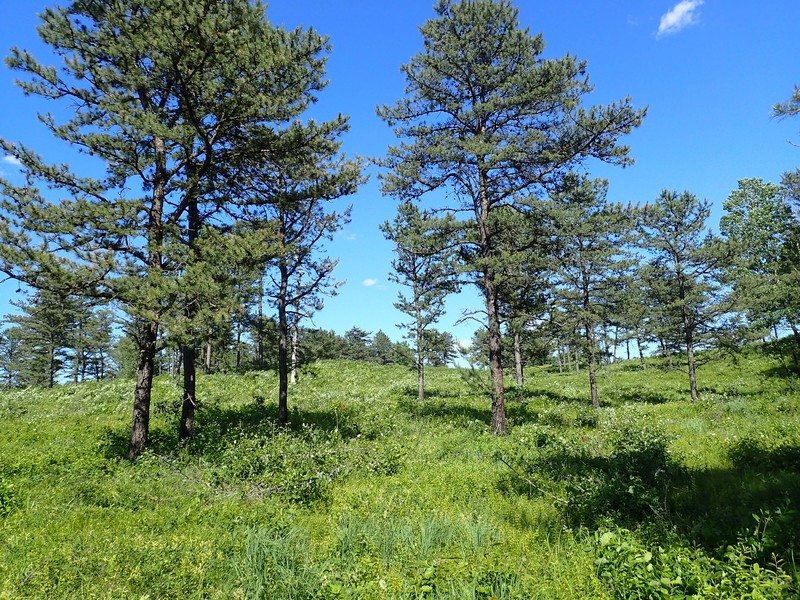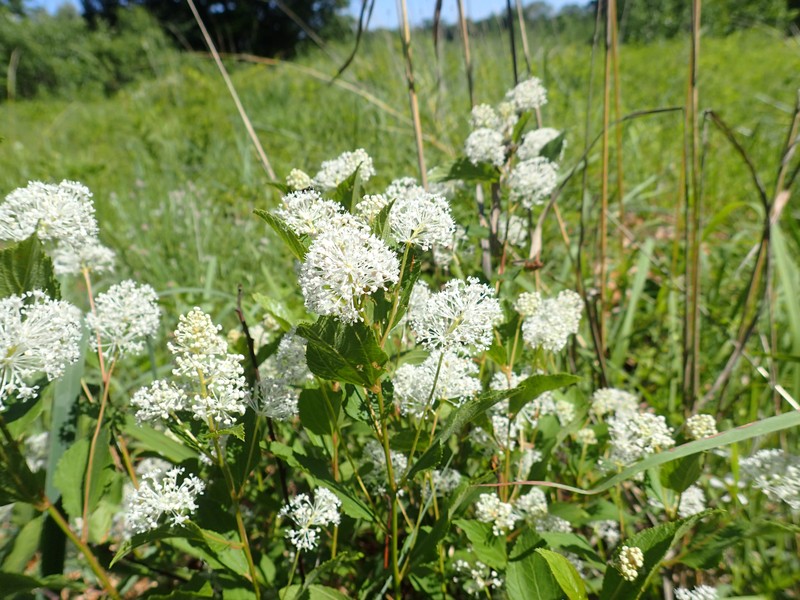Pitch Pine-Scrub Oak Barrens
- System
- Terrestrial
- Subsystem
- Barrens And Woodlands
- State Protection
- Not Listed
Not listed or protected by New York State.
- Federal Protection
- Not Listed
- State Conservation Status Rank
- S1
Critically Imperiled in New York - Especially vulnerable to disappearing from New York due to extreme rarity or other factors; typically 5 or fewer populations or locations in New York, very few individuals, very restricted range, very few remaining acres (or miles of stream), and/or very steep declines.
- Global Conservation Status Rank
- G2
Imperiled globally - At high risk of extinction due to rarity or other factors; typically 20 or fewer populations or locations in the world, very few individuals, very restricted range, few remaining acres (or miles of stream), and/or steep declines.
Summary
Did you know?
There are two shrubby oaks characteristic of pitch pine-scrub oak barrens: Scrub Oak or Bear Oak (Quercus ilicifolia) and Dwarf Chinquapin Oak (Quercus prinoides). Scrub Oak leaves have bristle-tipped teeth or lobes. Dwarf Chinquapin Oak leaves have rounded to acutely pointed teeth or lobes with an apical papilla (projection) and are not bristle-tipped.
State Ranking Justification
This is a globally rare natural community with only six documented occurrences statewide. Very few documented occurrences have good viability and very few are protected on public land or private conservation land. This community has a very restricted statewide distribution (correlated to pine barrens and sandy soils). Most examples are moderate in size and a few are good quality. Most pitch pine-scrub oak barrens are located within a suburban landscape and are threatened by development, invasive species, and fire suppression.
Short-term Trends
The number and acreage of pitch pine-scrub oak barrens in New York have probably declined slightly in recent decades due to fire suppression, disturbance by off-road vehicles, trash dumping, and development.
Long-term Trends
The number and acreage of pitch pine-scrub oak barrens in New York have probably had very large declines from historical numbers due to fire suppression, fragmentation, disturbance by off-road vehicles, trash dumping, and development.
Conservation and Management
Threats
As a fire-dependent natural community, the primary threat to pitch pine-scrub oak barrens is the suppression of fire. Other threats to this community include fragmenting development (e.g., residential, agricultural, commercial, roads), recreational overuse (e.g., ATV use, hiking, trash dumping), and habitat alteration (e.g., excessive logging, utility ROWs). A few examples of pitch pine-scrub oak barrens are threatened by invasive species, such as black locust (Robinia pseudoacacia), aspens (Populus tremuloides, P. grandidentata), shrubby honeysuckles (Lonicera tatarica, L. morrowii), multiflora rose (Rosa multiflora), and garlic mustard (Alliara petiolata). Southern pine beetle (Dendroctonus frontalis) is a bark beetle that infests pine trees, such as pitch pine, white pine, and red pine. Southern pine beetle is native to the southeastern United States, but its range has spread up the east coast to Long Island, New York in 2014. Natural communities dominated or co-dominated by pines would likely be most impacted by southern pine beetle invasion.
Conservation Strategies and Management Practices
Develop and implement prescribed burn plans at appropriate sites. Reduce or minimize fragmenting features, such as residential and commercial development, roads, abandoned clearings, unnecessary trails, etc. Restrict mountain bikes and ATVs to designated trails and least sensitive areas, and prevent dumping of trash. Remove or control invasive species where appropriate.
Development and Mitigation Considerations
Soils are very sandy and well-drained within this community, and the effect of clearing and construction on soil retention and erosion must be considered during any development activities. Similarly, these soils are acidic and nutrient-poor and any soil enrichment contamination (e.g., from septic leach fields or fertilized lawns) can alter community structure and function. The open structure of this community is maintained by fire and presents a fire hazard to existing and proposed development. Unprotected structures located within or near this community are more susceptible to damage from fire.
Inventory Needs
Inventory all occurrences with records greater than ten years old. Inventory sites in Saratoga County to determine if this community is present.
Research Needs
Determine the optimal fire regime for this community. Research the composition of pitch pine-scrub oak barrens on Long Island and compare them to inland examples (e.g., Albany Pine Bush) in order to characterize variations and possibly recognize two separate types.
Rare Species
- Ageratina aromatica var. aromatica (Small White Snakeroot) (guide)
- Aletris farinosa (White Colicroot) (guide)
- Callophrys irus (Frosted Elfin) (guide)
- Carex barrattii (Barratt's Sedge) (guide)
- Carex cumulata (Clustered Sedge) (guide)
- Carex polymorpha (Variable Sedge) (guide)
- Cerma cora (Bird Dropping Moth) (guide)
- Chaetaglaea cerata (Waxed Sallow) (guide)
- Chordeiles minor (Common Nighthawk) (guide)
- Chytonix sensilis (Sensitive Chytonix) (guide)
- Cyperus schweinitzii (Schweinitz's Flat Sedge) (guide)
- Dargida rubripennis (The Pink Streak) (guide)
- Erastria coloraria (Broad-lined Catopyrrha) (guide)
- Eucoptocnemis fimbriaris (Fringed Dart) (guide)
- Eupatorium subvenosum (Veined Thoroughwort) (guide)
- Euphorbia ipecacuanhae (Ipecac Spurge) (guide)
- Eurybia spectabilis (Showy Aster) (guide)
- Hemileuca maia maia (Inland Barrens Buckmoth) (guide)
- Hemileuca maia ssp. 5 (Coastal Barrens Buckmoth) (guide)
- Hypericum prolificum (Shrubby St. John's Wort) (guide)
- Kinosternon subrubrum (Eastern Mud Turtle) (guide)
- Lactuca hirsuta (Tall Hairy Lettuce) (guide)
- Lechea tenuifolia (Narrow-leaved Pinweed) (guide)
- Lespedeza angustifolia (Narrow-leaved Bush Clover) (guide)
- Lespedeza stuevei (Stuve's Bush Clover) (guide)
- Linum intercursum (Sandplain Wild Flax) (guide)
- Linum medium var. texanum (Texas Wild Flax) (guide)
- Lithospermum canescens (Hoary Puccoon) (guide)
- Macaria signaria (Jack Pine Looper) (guide)
- Macrochilo bivittata (Two-striped Cord Grass Moth) (guide)
- Malaxis bayardii (Bayard's Adder's Mouth Orchid) (guide)
- Melanerpes erythrocephalus (Red-headed Woodpecker) (guide)
- Myotis septentrionalis (Northern Long-eared Bat) (guide)
- Plebejus melissa samuelis (Karner Blue) (guide)
- Ranunculus micranthus (Small-flowered Buttercup) (guide)
- Satyrium edwardsii (Edwards' Hairstreak) (guide)
- Scaphiopus holbrookii (Eastern Spadefoot) (guide)
- Scleria pauciflora var. caroliniana (Few-flowered Nutrush) (guide)
- Sericocarpus linifolius (Narrow-leaved White-topped Aster) (guide)
- Silene caroliniana ssp. pensylvanica (Wild Pink) (guide)
- Symphyotrichum concolor var. concolor (Eastern Silvery Aster) (guide)
- Viola brittoniana (Britton's Coast Violet) (guide)
- Zanclognatha martha (Pine Barrens Zanclognatha) (guide)
Range
New York State Distribution
In New York, this community is restricted to the following three areas underlain by glacial sand deposits: 1) the Hudson Valley in Albany and Warren Counties within the Hudson Glacial Lake Plains subsection, 2) the Long Island Lowland and Moraine subsection of the Mid-Atlantic Coastal Plain in Suffolk County, and 3) in Saratoga County within the Saratoga Sandplains.
Global Distribution
This community is known from the Hudson-Mohawk valley in eastern New York, west-central Long Island, and the inland regions of Massachusetts, New Hampshire, Connecticut, and Rhode Island.
Best Places to See
- Edgewood Oak Brush Plains Preserve (Suffolk County)
- Albany Pine Bush Preserve
- Adirondack Park (Warren County)
Identification Comments
General Description
A pine barrens community with a shrub layer dominated by scrub oaks underlain by heath species. The shrub layer forms a thicket that covers 60 to 80% of the community. Embedded within the shrub thickets are small patches of savanna, dominated by various forbs and prairie grasses (i.e., successional northern sandplain grasslands). The community occurs on well-drained sandy soils that have developed on sand dunes, glacial till, and outwash. This community is adapted to and maintained by periodic fires with a frequency ranging from 6 to 15 years.
Characters Most Useful for Identification
Pitch pine (Pinus rigida) is the dominant tree and forms an open canopy of 20 to 60% cover. The shrub layer is dominated by scrub oaks (Quercus ilicifolia, Q. prinoides), and heath species such as lowbush blueberry (Vaccinium angustifolium, V. pallidum), and black huckleberry (Gaylussacia baccata). Scattered within the shrub thicket are savanna openings dominated by herbaceous species such as little bluestem (Schizachyrium scoparium), Indian grass (Sorghastrum nutans), big bluestem (Andropogon gerardii), bush-clovers (Lespedeza spp.), and wild lupine (Lupinus perennis).
Elevation Range
Known examples of this community have been found at elevations between 70 feet and 485 feet.
Best Time to See
In the spring, summer and fall pitch pine-scrub oak barrens can be very hot and dry. Remember to bring drinking water and sunscreen. Fall is good time of year to see the scrub oak thickets turn color and perhaps avoid some of the biting insects.
Pitch Pine-Scrub Oak Barrens Images
Classification
International Vegetation Classification Associations
This New York natural community encompasses all or part of the concept of the following International Vegetation Classification (IVC) natural community associations. These are often described at finer resolution than New York's natural communities. The IVC is developed and maintained by NatureServe.
- Pitch Pine / Bear Oak / Round-head Bushclover Woodland (CEGL006025)
- Bear Oak - Dwarf Chinkapin Oak Scrub (CEGL006111)
- Little Bluestem - (Broomsedge Bluestem) - Goldenrod species Ruderal Meadow (CEGL006333)
NatureServe Ecological Systems
This New York natural community falls into the following ecological system(s). Ecological systems are often described at a coarser resolution than New York's natural communities and tend to represent clusters of associations found in similar environments. The ecological systems project is developed and maintained by NatureServe.
- Northeastern Interior Pine Barrens (CES202.590)
Characteristic Species
-
Trees > 5m
- Pinus rigida (pitch pine)
- Populus tremuloides (trembling aspen, quaking aspen)
- Quercus coccinea (scarlet oak)
-
Shrubs 2 - 5m
- Quercus ilicifolia (scrub oak, bear oak)
- Quercus prinoides (dwarf chestnut oak)
-
Shrubs < 2m
- Aronia melanocarpa (black chokeberry)
- Ceanothus americanus (New Jersey-tea)
- Comptonia peregrina (sweet-fern)
- Gaylussacia baccata (black huckleberry)
- Kalmia angustifolia var. angustifolia (sheep laurel, sheep-kill)
- Salix humilis var. tristis (dwarf prairie willow)
- Vaccinium angustifolium (common lowbush blueberry)
- Vaccinium pallidum (hillside blueberry)
-
Herbs
- Andropogon gerardi (big bluestem)
- Apocynum androsaemifolium (spreading dogbane)
- Asclepias amplexicaulis (blunt-leaved milkweed)
- Asclepias tuberosa (butterfly-weed)
- Carex pensylvanica (Pennsylvania sedge)
- Comandra umbellata ssp. umbellata (bastard-toadflax)
- Desmodium canadense (showy tick-trefoil)
- Lespedeza capitata (round-headed bush-clover)
- Lilium philadelphicum (wood lily)
- Lupinus perennis ssp. perennis (wild lupine, sundial lupine)
- Lysimachia quadrifolia (whorled-loosestrife)
- Melampyrum lineare (cow-wheat)
- Monarda punctata var. villicaulis (hairy horse-mint)
- Polygala sanguinea (blood milkwort)
- Pteridium aquilinum ssp. latiusculum (eastern bracken fern)
- Schizachyrium scoparium var. scoparium (little bluestem)
- Sorghastrum nutans (Indian grass)
- Tephrosia virginiana (goat's-rue)
Similar Ecological Communities
- Pitch pine-heath barrens
(guide)
Pitch pine-heath barrens have a shrub cover that is dominated more heavily by heath species than pitch pine-scrub oak barrens, and they lack the scattered herb-dominated savanna openings.
- Pitch pine-oak forest
(guide)
Pitch pine-oak forest is a closed-canopy mature community. Pitch pine-scrub oak barrens are shrub-savanna communities with a sparse canopy.
- Pitch pine-oak-heath woodland
(guide)
Pitch pine-oak-heath woodland communities have a more extensive canopy cover than pitch pine-scrub oak barrens, and a less diverse herbaceous layer.
Vegetation
Percent cover
This figure helps visualize the structure and "look" or "feel" of a typical Pitch Pine-Scrub Oak Barrens. Each bar represents the amount of "coverage" for all the species growing at that height. Because layers overlap (shrubs may grow under trees, for example), the shaded regions can add up to more than 100%.
Additional Resources
References
Bernard, J.M. and F.K. Seischab. 1995. Pitch pine (Pinus rigida Mill.) communities in northeastern New York State. American Midland Naturalist 134:294-306.
Cryan, John F. and John L. Turner. 1981. A Landscape Imperiled: The Long Island Oak Brush Plains. The Heath Hen 1(2-3):3-34.
Drennan, S.R. 1981. Where to Find Birds in New York State. Syracuse University Press, Syracuse, NY.
Edinger, G. J., D. J. Evans, S. Gebauer, T. G. Howard, D. M. Hunt, and A. M. Olivero (editors). 2014. Ecological Communities of New York State. Second Edition. A revised and expanded edition of Carol Reschke’s Ecological Communities of New York State. New York Natural Heritage Program, New York State Department of Environmental Conservation, Albany, NY. https://www.nynhp.org/ecological-communities/
Edinger, Gregory J., D.J. Evans, Shane Gebauer, Timothy G. Howard, David M. Hunt, and Adele M. Olivero (editors). 2002. Ecological Communities of New York State. Second Edition. A revised and expanded edition of Carol Reschke's Ecological Communities of New York State. (Draft for review). New York Natural Heritage Program, New York State Department of Environmental Conservation. Albany, NY. 136 pp.
Environmental Design and Research, P.C., M. Batcher, and Behan Planning Associates. 2002. Albany Pine Bush Management Plan and Final Environmental Impact Statement. Prepared for the Albany Pine Bush Commission, Latham, NY.
Finton, Andrew D. 1998. Succession and plant community development in pitch pine-scrub oak barrens of the glaciated northeast United States. Masters thesis submitted to the graduate school of the University of Massachusetts at Amherst, MA.
Forman, Richard T.T. (editior). 1979. Pine Barrens: Ecosystem and Landscape. Academic Press, New York, NY
Grossman, D. H., K. Lemon Goodin, and C. L. Reuss, editors. 1994. Rare plant communities of the conterminous United States: An initial survey. The Nature Conservancy. Arlington, VA. 620 pp.
Kerlinger, P. and C. Doremus. 1981. The breeding birds of three pine barrens in New York State. The Kingbird 31:126-135.
Levine, E. 1998. Bull's birds of New York State. Comstock Publishing Associates, Ithaca, NY.
Milne, B.T. 1979. A preliminary list of lichens of the Albany Pine Bush. Skenectada 1:36-38.
Milne, Bruce T. 1985. Upland vegetational gradients and post-fire succession in the Albany Pine Bush, New York. Bulletin of the Torrey Botanical Club 112(1): 21-34.
Motzkin, G., W.A. Patterson III, and D.R. Foster. 1999. A historical perspective on pitch pine-scrub oak communities in the Connecticut Valley of Massachusetts. Ecosystems 2:255-273.
NatureServe. 2015. NatureServe Explorer: An online encyclopedia of life [web application]. Version 7.1. NatureServe, Arlington, Virginia. Available http://www.natureserve.org/explorer.
New York Natural Heritage Program. 2024. New York Natural Heritage Program Databases. Albany, NY.
Olsvig, L.S. 1980. A comparative study of northeastern Pine Barrens vegetation. Ph.D. dissertation, Cornell University, Ithaca, NY. 479 pp.
Reschke, Carol. 1990. Ecological communities of New York State. New York Natural Heritage Program, New York State Department of Environmental Conservation. Latham, NY. 96 pp. plus xi.
Rittner, D. 1979. An early history of Pine Bush entomology. Skenetada Vol. 1, pp. 3-35.
Schneider, Kathryn J., Carol Reschke and Steve M. Young. 1991. Inventory of the rare plants, animals and ecological communities of the Albany Pine Bush Preserve. A report to the Albany Pine Bush Commission. New York Natural Heritage Program, New York State Department of Environmental Conservation. Latham, NY. 67 pp. plus maps.
Stewart, M.M. and J. Rossi. 1981. The Albany Pine Bush: A northern outpost for southern species of amphibians and reptiles in New York. The American Midland Naturalist 106:282-292.
Widoff, L. 1988. Pitch pine/scrub oak barrens in Maine. Planning Report No. 86. Critical Areas Program, Maine State Planning Office, Augusta, ME, and Maine Natural Heritage Program, Topsham, ME. 104 pp.
Links
About This Guide
Information for this guide was last updated on: May 16, 2024
Please cite this page as:
New York Natural Heritage Program. 2024.
Online Conservation Guide for
Pitch pine-scrub oak barrens.
Available from: https://guides.nynhp.org/pitch-pine-scrub-oak-barrens/.
Accessed July 26, 2024.

